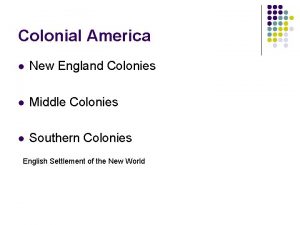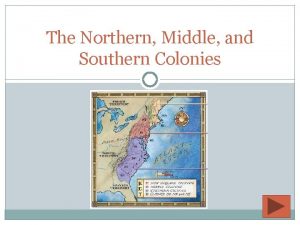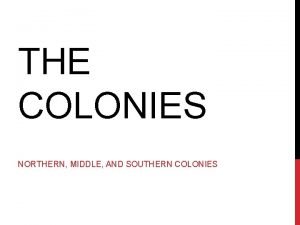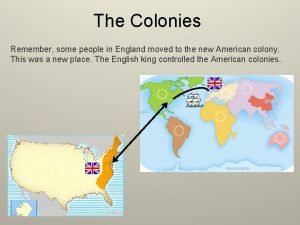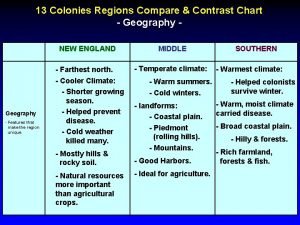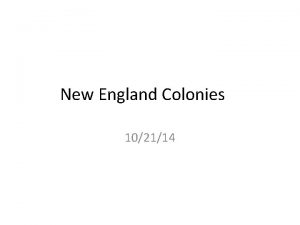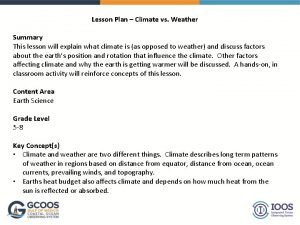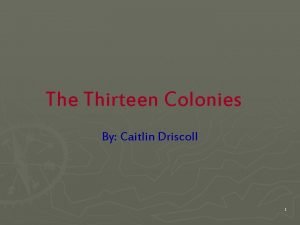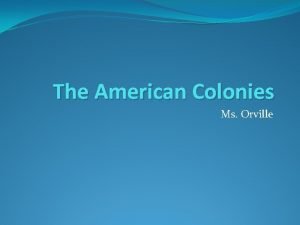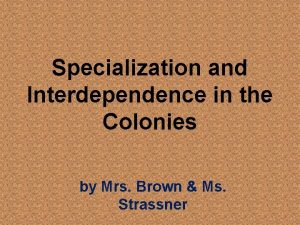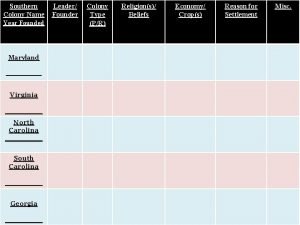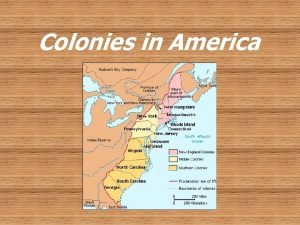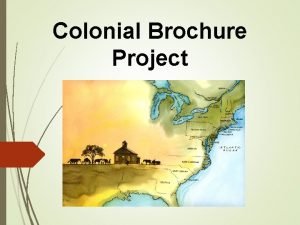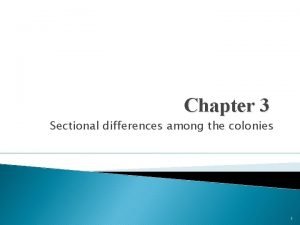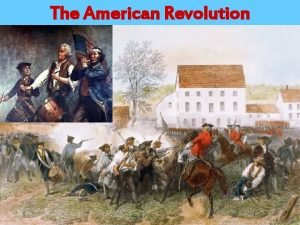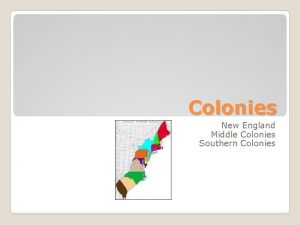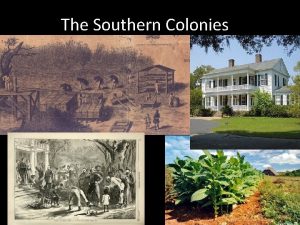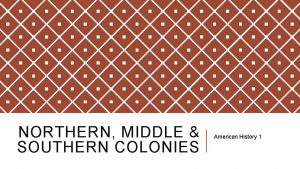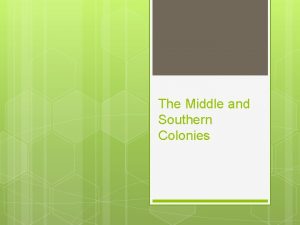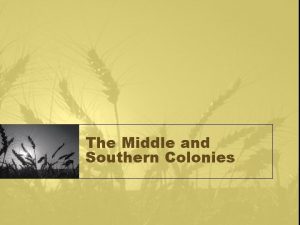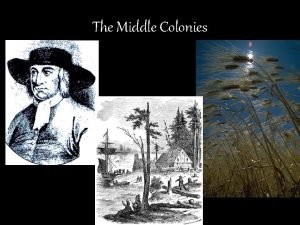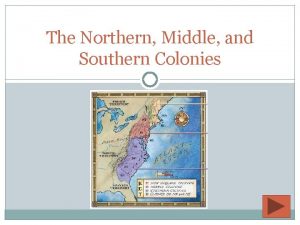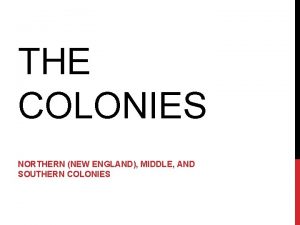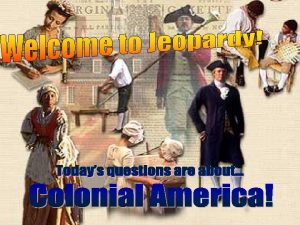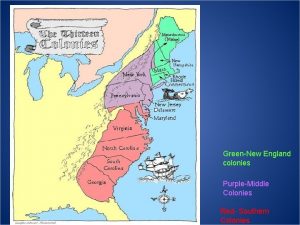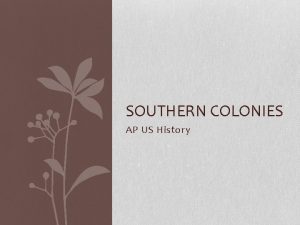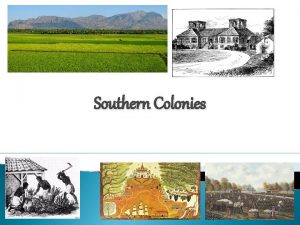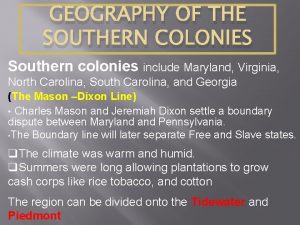The Northern Middle and Southern Colonies The New




















- Slides: 20

The Northern, Middle, and Southern Colonies

The New England Colonies

Geography Location New Hampshire, Vermont, Maine, Massachusetts, Connecticut, and Rhode Island Terrain Hills and low mountains, narrow plains along coast Thin and rocky soil (difficult for farming) Weather and Resources Large areas covered by forests Richest fishing in the world off the coastline

Establishment Chartered by the Puritans Wanted to reform the Church of England Persecuted by King Charles I in 1620 s Left England in 1630 900 puritans on 11 ships Known as the Massachusetts Bay Company Led by John Winthrop

Growth and Change New England colonists earned their livelihoods in several different ways Leather goods, fishing, shipbuilding English colonies were free to expand after the end of the Native American Uprising called King Philips War Stern religious rule had less influence over the later generations than it did over the original founders

New England Colonies – Comprehension Check Question 1: Why were the New England Colonies founded? A. Religious freedom B. Sandy soil that was ideal for growing tobacco

New England Colonies – Comprehension Check Question 2: How did most New England colonists make their living? A. Wheat farming B. Fishing and shipbuilding Need to review the New England Colonies? Start at the beginning:

The Middle Colonies

Geography Location New York, Pennsylvania, New Jersey, and Delaware Terrain Mostly lowland Weather and Resources Warmer climate, with longer growing season Fertile soil well suited for wheat, fruits, and vegetables

Establishment New York began as the Dutch colony of New Netherland Was an economic success (farming and trade) In 1664 King Charles II of England granted all Dutch lands to his brother James sent warships and the Dutch surrendered immediately The colony was then renamed New York NEW YORK

Growth and Change Wheat was the top cash crop in this area, produced by small farms Wheat = America’s breadbasket Manufacturing and Trade Artisans were also prevalent Non-English immigrants made the Middle Colonies the most diverse part of English North America

Middle Colonies – Comprehension Check Question 1: Where did most of the colonists in the Middle Colonies come from? A. Spain B. Netherlands

Middle Colonies – Comprehension Check Question 2: What is the main cash crop in the Middle Colonies? A. Cotton B. Wheat Need to review the Middle Colonies? Start at the beginning:

The Southern Colonies

Geography Location South of the Mason-Dixon Line Maryland, Virginia, North Carolina, South Carolina, and Georgia Terrain Coastal area (Tidewater) Flat lowland with many swampy areas Rolling hills (Piedmont) Weather and Resources Climate is warm and humid Hot summers with long growing season Farming: tobacco and rice

Establishment In 1632 King Charles I granted charter for a colony in Maryland Chartered by the Catholics Were discriminated greatly in England Led by George Calvert Goal: to create a colony where Catholics could live safely First settlers included both Catholics and Protestants Religious toleration Act of Toleration in 1649 All adult male Christians the right to vote and hold office

Growth and Change Two distinct ways of life The Tidewater region Plantations – crops of cotton, sugar, tobacco, and rice Helped promote the spread of slavery The Backcountry Cut off from the coast by poor roads and long distances Families lived in isolated farms

Southern Colonies – Comprehension Check Question 1: What is the climate in the Southern Colonies? A. Cold and rainy B. Warm and humid

Southern Colonies – Comprehension Check Question 2: What are the two distinct ways of life in the Southern Colonies? A. Tidewater and Backcountry B. Tidewater and Piedmont Need to review the Southern Colonies? Start at the beginning:

Summary The English colonies developed along distinct regional lines They were founded for many reasons including religious and political freedom, economy, and conquest Do you need more time to review? Start over:
 New england middle and southern colonies venn diagram
New england middle and southern colonies venn diagram Northern middle and southern colonies
Northern middle and southern colonies What are the names of the southern colonies
What are the names of the southern colonies Site:slidetodoc.com
Site:slidetodoc.com New england, middle and southern colonies comparison chart
New england, middle and southern colonies comparison chart New england, middle and southern colonies comparison chart
New england, middle and southern colonies comparison chart New england region
New england region Parts of globe
Parts of globe Southern states vs northern states
Southern states vs northern states Religion southern colonies
Religion southern colonies Characteristics of the southern colonies
Characteristics of the southern colonies Caitlin driscoll
Caitlin driscoll Economy of southern colonies
Economy of southern colonies Southern colonies
Southern colonies Specialization and interdependence
Specialization and interdependence Southern colony religion
Southern colony religion New england confederation participants
New england confederation participants New england colonies brochure
New england colonies brochure Economy of southern colonies
Economy of southern colonies Southern colonies
Southern colonies Cudgeling sport
Cudgeling sport
